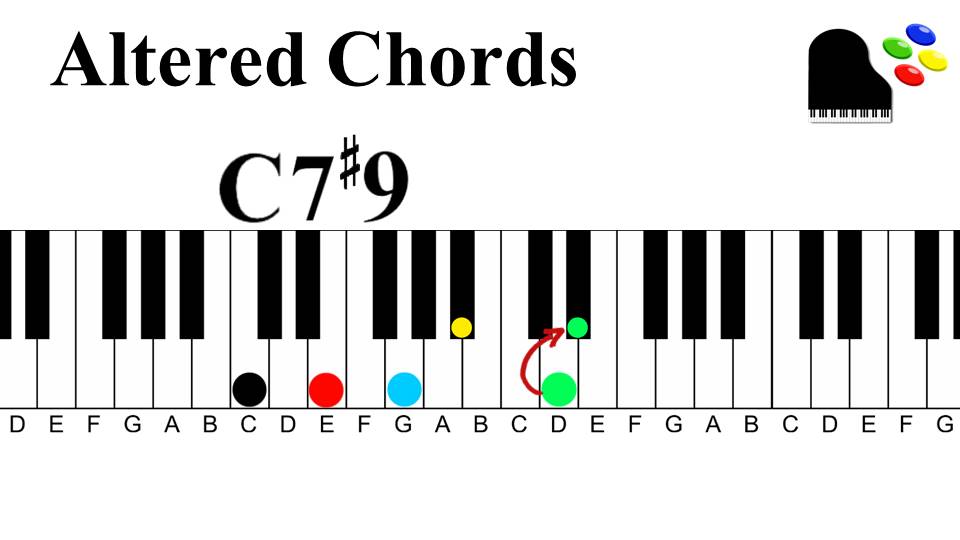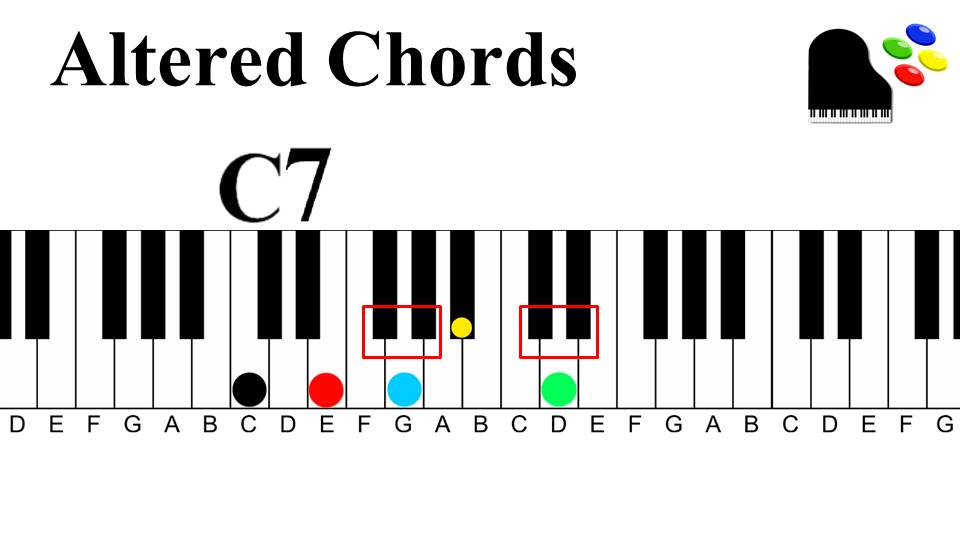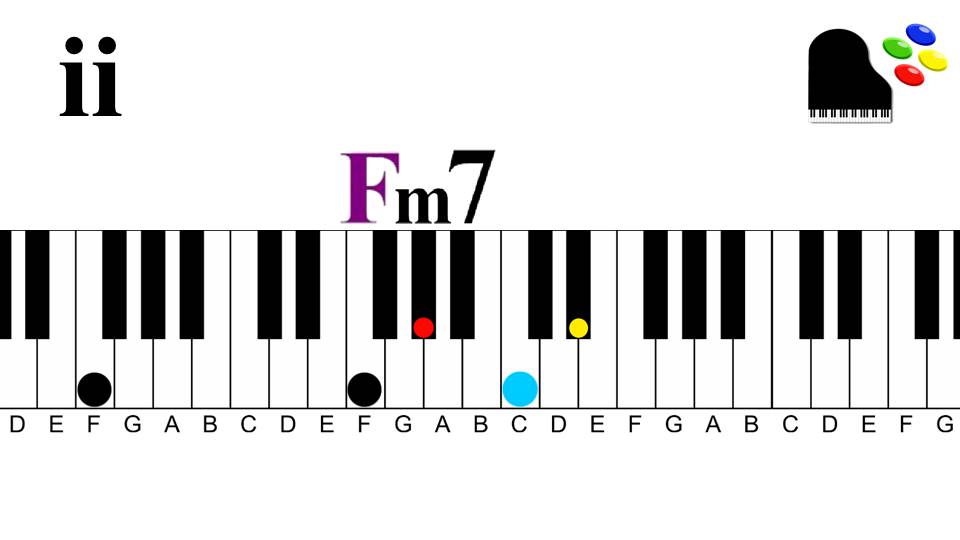 No, you're not experiencing "Deja Vu". We're starting out in the key of E flat Major again in our "Gospel Progression Part 2 article. Just as I stated in our last article, notice how the 7 different colors represent the 7 different notes in the key.
No, you're not experiencing "Deja Vu". We're starting out in the key of E flat Major again in our "Gospel Progression Part 2 article. Just as I stated in our last article, notice how the 7 different colors represent the 7 different notes in the key.
 We're using the 1-6-2-5 Chord Progression just as we did in Gospel Progression | Part 1.
We're using the 1-6-2-5 Chord Progression just as we did in Gospel Progression | Part 1.
 (Yes this is a different article than last time) Our I chord is a simple E flat Major chord. The left hand is playing the root in octaves while the right hand is voicing the E flat Major chord with the root on top.
(Yes this is a different article than last time) Our I chord is a simple E flat Major chord. The left hand is playing the root in octaves while the right hand is voicing the E flat Major chord with the root on top.
 Let's play this simple chord vamp again known as plagal cadence, which I stated in our last article as a I chord to a IV chord. Again we're giving this plagal cadence some variety. Notice we're still playing the IV chord over the I chord. I referred to it as a polychord which is defined as one chord over another. Let me also add that the left hand E flat 7 chord is also known as a shell voicing. It just includes the root and the dominant 7th.
Let's play this simple chord vamp again known as plagal cadence, which I stated in our last article as a I chord to a IV chord. Again we're giving this plagal cadence some variety. Notice we're still playing the IV chord over the I chord. I referred to it as a polychord which is defined as one chord over another. Let me also add that the left hand E flat 7 chord is also known as a shell voicing. It just includes the root and the dominant 7th.
 This plagal cadence will take us back to the I chord as it did last time. Notice that it's voiced the same as in the beginning of our progression. You can cycle through this plagal cadence a few times and then proceed to the rest of our Gospel chord progression.
This plagal cadence will take us back to the I chord as it did last time. Notice that it's voiced the same as in the beginning of our progression. You can cycle through this plagal cadence a few times and then proceed to the rest of our Gospel chord progression.
 Ok, we're done with "Groundhog Day", (for the most part). Let's take another detour before we move into our altered chords for our Gospel progression Part 2 article.
Ok, we're done with "Groundhog Day", (for the most part). Let's take another detour before we move into our altered chords for our Gospel progression Part 2 article.
 Even though we're playing in the key of E flat, let's play this E flat minor 7 chord to get us going. The root is played in octaves in the left hand while the right hand plays what very convincingly looks like a G flat Major chord. Put them together and you get an E flat minor 7 chord.
Even though we're playing in the key of E flat, let's play this E flat minor 7 chord to get us going. The root is played in octaves in the left hand while the right hand plays what very convincingly looks like a G flat Major chord. Put them together and you get an E flat minor 7 chord.
 While still keeping the E flat in octaves in your left hand, we'll play a D flat Major chord in our right hand. This D flat Major chord is based on the flatted 7th tone of the key of E flat.
While still keeping the E flat in octaves in your left hand, we'll play a D flat Major chord in our right hand. This D flat Major chord is based on the flatted 7th tone of the key of E flat.
 Altered chords were very much a staple of jazz music at one time. However, they're quite common in most all styles of music today. This is true especially in Gospel music. They're often used as transitional chords that are played between the main chords in a song, but as you'll see in this article, they can also be used on the actual chord tones of the progression.
Altered chords were very much a staple of jazz music at one time. However, they're quite common in most all styles of music today. This is true especially in Gospel music. They're often used as transitional chords that are played between the main chords in a song, but as you'll see in this article, they can also be used on the actual chord tones of the progression.
The great thing about altered chords is that they add so much to a chord progression. Just as diminished chords, they don't stand on their own, but create a very rich experience when interjected into the simplest chord progression.
 Most (but not all) altered chords are dominant 7th chords. One example of an altered chord is the 7 flat 5. Notice in the card above that you can create this altered chord by simply lowering the 5th down a half step. In this case, we're moving the G down to G flat.
Most (but not all) altered chords are dominant 7th chords. One example of an altered chord is the 7 flat 5. Notice in the card above that you can create this altered chord by simply lowering the 5th down a half step. In this case, we're moving the G down to G flat.
 Another example of an altered chord is a 7 sharp 9 chord. We're raising the 9th up a half step to a D sharp as it's referred to in this context.
Another example of an altered chord is a 7 sharp 9 chord. We're raising the 9th up a half step to a D sharp as it's referred to in this context.
 You've probably noticed that altered tones are not native to the chord in which they're added to. In other words, they're not diatonic notes. That's what gives them such an interesting texture. The simplest way to understand how altered chords are formed, is to recognize that there are two notes in which altered chords are always a half step away from. That is the 9th and the 5th. In our example in the card above, it's D (9th) and G (5th).
You've probably noticed that altered tones are not native to the chord in which they're added to. In other words, they're not diatonic notes. That's what gives them such an interesting texture. The simplest way to understand how altered chords are formed, is to recognize that there are two notes in which altered chords are always a half step away from. That is the 9th and the 5th. In our example in the card above, it's D (9th) and G (5th).
 Now that we've gained an understanding of altered chords, let's proceed on with our altered chords Gospel progression. We're on to the VI chord and we're playing it as a C7 sharp 9 sharp 5.
Now that we've gained an understanding of altered chords, let's proceed on with our altered chords Gospel progression. We're on to the VI chord and we're playing it as a C7 sharp 9 sharp 5.
 We could go straight to the ii chord, but let's showcase another altered chord by passing through the flat ii chord. Here, we're playing an E9 flat 5 chord as a passing chord before we move to the ii chord.
We could go straight to the ii chord, but let's showcase another altered chord by passing through the flat ii chord. Here, we're playing an E9 flat 5 chord as a passing chord before we move to the ii chord.
 Now it's resolution time. We move to the ii chord which is a very simple Fm7 chord. The preceding altered chords have created tension that have now been resolved by a minor 7 chord.
Now it's resolution time. We move to the ii chord which is a very simple Fm7 chord. The preceding altered chords have created tension that have now been resolved by a minor 7 chord.
 If this A diminished 7th chord looks familiar, it's not your imagination. We used it in Gospel progression Part 1. It's the A diminished 7th chord and again, we're playing it with the root and diminished 7th in the left hand and that stack of minor 3rds in the right.
If this A diminished 7th chord looks familiar, it's not your imagination. We used it in Gospel progression Part 1. It's the A diminished 7th chord and again, we're playing it with the root and diminished 7th in the left hand and that stack of minor 3rds in the right.
 We're using the same V chord voicing in our Part 2 Gospel progression. It's the IV chord over the V chord which is structurally an 11th chord. You can play this chord voicing with the root and 5th of B flat in left hand and the A flat triad in the right. Of course, it's also an option to play the B flat in left hand octaves and the rest of the chord in the right because the tones are so close together.
We're using the same V chord voicing in our Part 2 Gospel progression. It's the IV chord over the V chord which is structurally an 11th chord. You can play this chord voicing with the root and 5th of B flat in left hand and the A flat triad in the right. Of course, it's also an option to play the B flat in left hand octaves and the rest of the chord in the right because the tones are so close together.
 Now we're back to our I chord in our 6-2-5-1 Gospel chord progression. Watch the video on altered chords to see a demo of our Gospel chord progression 2 on altered chords.
Now we're back to our I chord in our 6-2-5-1 Gospel chord progression. Watch the video on altered chords to see a demo of our Gospel chord progression 2 on altered chords.
In this Video & Cards article, we showcased augmented chords and how they're used in Part 2 of our Gospel Progression. This is only scratching the surface of altered chords, but I hope with this article it's given you an idea of how to use altered chords in your own music, so you can add more flavor to any song instead of just playing the same basic chords.
Until next time, Go Play!
Greg Lee
Latest posts by Greg Lee (see all)
- What is a minor/Major 7 Chord? - October 26, 2023
- 7 Chord Substitutions that Professionals Use - October 19, 2023
- 5 Simple Chord Tricks to Sound Amazing - October 5, 2023



